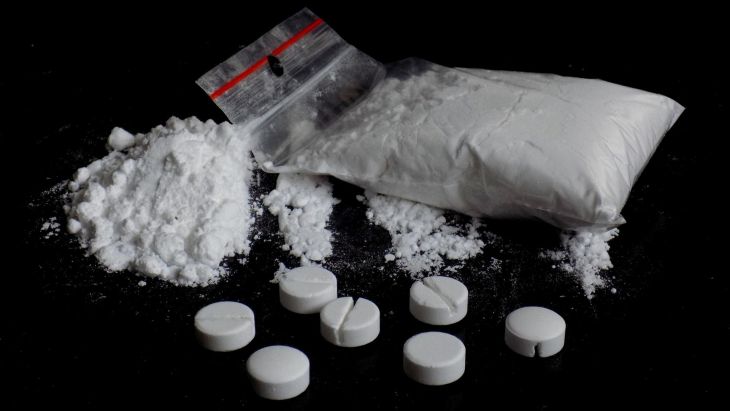Australia's first government pill-testing service, CanTEST Health and Drug Checking, opened in Canberra in July for a six-month pilot. Users of the service can present drugs for on-site analysis, and access information and advice from harm reduction workers based on the analytical results they receive.
We are the scientists behind this drug checking service. Results from the first month provide a fascinating window on the local drug scene. They also suggest the service is reaching a far broader cross section of the drug-taking community than what was possible from Australia's first festival-based pill testing services conducted in previous years.
In the first month of the service 58 samples were analysed. A broad range of items presented for analysis included many of the anticipated 'usual suspects'- cocaine, heroin, ketamine, MDMA and methamphetamine. However, a range of more exotic drugs were also expected. This included a distant cousin to MDMA, 6-APB; the psychedelic drug 2C-B; and the cosmonaut calming drug phenibut, among others. The diversity of drugs presented contrasts with the findings of pill testing trial at Canberra's Groovin' the Moo festival where 86 per cent of samples presented were expected to be MDMA.
What did we find?
In the majority of cases, the sample presented contained the expected drug, however there was also a small but sizable minority where adulteration, or even substitution for a different substance, was observed.
All heroin samples presented contained heroin, with purities ranging from 31 to 63 per cent. In contrast, only three of five cocaine samples actually contained cocaine, with purities below 27 per cent. One presentation lacked cocaine entirely, instead containing the relatively benign crystalline substance, dimethyl sulfone - an organic compound containing sulphur. This might be of further concern to those monitoring the surge of cocaine in Australia in recent months.
On the more unusual end of the spectrum was the presentation of 6-APB, a drug structurally related to MDMA and reported to give similar effects. It has been found previously in Canberra. However, the sample we tested was found to be the stimulant drug 4-EMC -- a compound earlier identified in Australian wastewater samples.
One ketamine sample presented was shown not to contain ketamine at all, but an unknown substance. Later laboratory analysis at the ANU Research School of Chemistry determined this to be fluorexetamine (not to be confused with 'fluoxetine', or Prozac, the antidepressant drug). Fluorexetamine is a ketamine derivative for which there is almost no scientific information available. The presence of such unheralded substances in a ketamine sample raises obvious concerns, as little is known about the safety or effects of compounds that have not been subject to scientific or medical evaluation.
How do we test the samples?
The CanTEST analytical service builds on the expertise developed by Pill Testing Australia in the festival environment, using well-validated analytical approaches, and with results presented directly to clients and harm reduction workers.
One system we use is Fourier transform infra-red (FTIR), which identifies drugs from their infrared spectrum. In addition, we use an ultra-performance liquid chromatography-photo-diode array (UPLC-PDA) to separate compounds, then identify and quantify them from their UV absorbance.
FTIR is that same technology used to test drugs at festivals around the world. Ireland has just announced its first trial using the same technology. It is capable of reporting on major drug components in around two minutes.
However, the real pill testing fire power at CanTEST comes in the form of the UPLC-PDA analysis. This instrument can separate and identify drug components, and can also report on drug purity for 10 targeted drugs most likely to be presented. This takes a little longer at 10 minutes for sample preparation and analysis, but the wait is well worth it.
We don't just test drug purity; we also identify the presence of unexpected drug components. For example, one tablet we examined with low purity MDMA (9 per cent) was shown to contain methamphetamine and caffeine. UPLC-PDA not only tells you what is in the drug but also how much, helping service clients avoid some of the potential harms of drug use. This represents as considerable advance on the analytical capacity previously used in festival settings.
The service also uses fentanyl test strips (FTS) to look for fentanyl derivatives. To date, 15 samples have been tested using FTS with none showing signs of these dangerously potent synthetic opiates. This is good news, given the ravages fentanyl has wrought in North America's overdose epidemic.
Why do these results matter?
Despite the interesting findings already emerging from the CanTEST service, this is still not the most important part of what we do. The idea that Australia will ever be 'drug-free' is magical thinking, from a bygone era; an era that has singularly failed in the goals which it espoused.
Using the results obtained from the process, we are engaging with a new generation of young consumers, many of whom have never sought advice on their drug consumption before now.
For some, those decisions involve choosing not to consume the drugs that that they have volunteered to have tested.
For others, they may choose to use their drugs in a way that makes them less likely to be harmed.
For all, CanTEST, acts as the catalyst for a conversation that all of them deserve.
CanTEST is a collaboration between Directions Health Services, CAMHA, Pill Testing Australia and ACT Health, with advice provided by scientists from The Australian National University.
Associate Professor Malcolm McLeod is based at the ANU Research School of Chemistry and is Chemistry Lead for CanTEST and Pill Testing Australia.
Associate Professor David Caldicott is based at the ANU Medical School and Clinical Lead of Pill Testing Australia.







